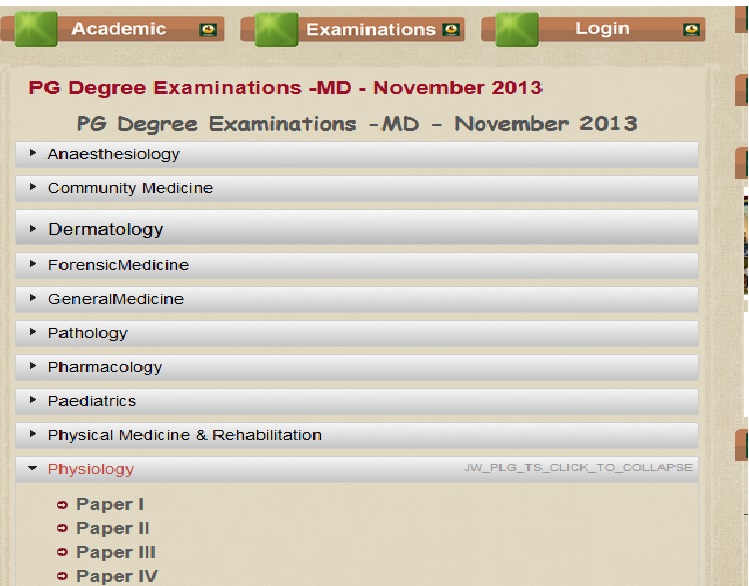Physiological Chemistry, Biophysics and Radiation Biology MD Question Paper : kuhs.ac.in
Name of the University : Kerala University of Health Sciences
Degree : PG Degree Examinations in Physiology (MD)
Subject Name : Physiological Chemistry, Biophysics and Radiation Biology
Paper : I,II,III & IV
Year : May 2013
Document Type : Model Question Paper
Website : kuhs.ac.in
Download Model/Sample Question Paper :
PAPER I : https://www.pdfquestion.in/uploads/kuhs.ac.in/3401-Paper%20I%20QP%20101114.pdf
PAPER II : https://www.pdfquestion.in/uploads/kuhs.ac.in/3401-Paper%20II%20QP%20102114.pdf
PAPER III : https://www.pdfquestion.in/uploads/kuhs.ac.in/3401-Paper%20III%20QP%20103114.pdf
PAPER IV : https://www.pdfquestion.in/uploads/kuhs.ac.in/3401-Paper%20IV%20QP%20104114.pdf
KUHS Physiology MD Previous Question Paper
PG Degree Examinations in Physiology (MD) – May 2013
Paper Ill : Physiological Chemistry, Biophysics and Radiation Biology
Time: 3 hrs
Max marks:100
Answer all questions :
Draw diagrams wherever necessary :
Related : KUHS Radiation Physics, Radiobiology &Other Basic Sciences MD Question Paper : www.pdfquestion.in/3399.html
May 2013
Paper I
Essays: (20)
1. Discuss the velocity-flow-pressure relationships in circulation.
Short essays: (8×10=80)
2. Management of radiation casualties
3. Patch clamping
4. Goldman-Hodgkin-Katz equation
5. Strength -duration relationship
6. Receptor potential
7. Denervation hypersensitivity
8. cAMP
9. Freshwater drowning

Paper II
General Physiology, Neuro Physiology, Including Special Senses and Endocrinology
Time: 3 hrs
Max marks:100
Answer all questions :
Draw diagrams wherever necessary :
Essays: (20)
1. Describe the components and functions of basal ganglia. Discuss in detail the clinical disorders and physiological basis of treatment.
Short essays: (8×10=80)
2. Molecular basis of smooth muscle contraction
3. Somatomedins
4. Measurement and regulation of extra cellular fluid volume
5. Corpus callosum
6. Neuro endocrine control of puberty
7. Biological actions of thyroxine
8. Regulation of satiety and thirst
9. Auditory pitch perception
Paper III
Applied Physiology Including Recent Advances
Time: 3 hrs
Maxmarks:100
Answer all questions :
Draw diagrams wherever necessary :
Essays: (20)
1. Describe the pathophysiology of clinical features of lesion at internal capsule. Explain the physiological basis of differences between upper motor neuron and lower motor neuron paralysis.
Short essays: (8×10=80)
2. Stemcell therapy
3. Role of hippocampus in learning and memory
4. Acute mountain sickness
5. Brainstem auditory evoked responses (BAER)
6. Hypocalcemic tetany
7. Diabetesinsipidus
8. Parkinson’s disease
9. Ventricular arrythmia
Paper IV
Systemic Physiology (Hematology, CVS, GIT, Respiratory System, Renal Physiology)
Time: 3 hrs
Maxmarks:100
Answer all questions :
Draw diagrams wherever necessary :
Essays: (20)
1. Discuss the short-term regulation of blood pressure. Add a note on experimental hypertension
Short essays: (8×10=80)
2. Flow- volume curve of lung
3. Plasma clearance studies and significance
4. Neutrophil phagocytosis
5. Motilin
6. Shamfeeding
7. Haldane effect
8. Abnormalities of micturition
9. Structural suitability of blood vessels with regard to its function
November 2013
Paper I
General Physiology, Neuro Physiology, Including Special Senses and Endocrinology
Time: 3 hrs
Max marks:100
Answer all questions
Draw diagrams wherever necessary
Essays: (20)
1. Discuss the role of vestibular apparatus in the maintenance of equilibrium and balance.
Short essays: (10×8=80)
2. Cell adhesion molecules
3. Dark adaptation
4. Somatomedins
5. Abnormalities of sex differentiation
6. Physiological actions of parathyroid hormone
7. Deafferentation
8. Synaptic inhibition
9. Cortical plasticity
Paper II
Systemic Physiology (Hematology, CVS, GIT, Respiratory System, Renal Physiology)
Time: 3 hrs
Max marks:100
Answer all questions
Draw diagrams wherever necessary
Essays: (20)
1. Describe the circulatory responses to neurogenic and circulatory shock
Short essays: (8×10=80)
2. Principles of electrocardiography.
3. Cheyne – Stokes respiration
4. Pressure changes during normal respiratory cycle.
5. Mismatched blood transfusion
6. T lymphocytes in immunity
7. Renin-angiotensin aldosterone mechanisms.
8. Counter current exchange mechanism in the kidney.
9. Enteric nervous system.
Paper III
Physiological Chemistry, Biophysics and Radiation Biology
Time: 3 hrs
Max marks:100
Answer all questions
Draw diagrams wherever necessary
Essays: (20)
1. Describe the Laplace law and its application in physiology
Short essays: (8×10=80)
2. Osmo receptors in regulation of ECF
3. Inhibitions in spinal cord.
4. Electrochemical equilibrium across the cell membrane
5. Isotopes and their uses in physiology
6. Smooth muscle contraction
7. Siggard Anderson curve nomogram
8. Molecular motors
9. Pressure volume relationship in urinary bladder
Paper IV
Applied Physiology Including Recent Advances
Time: 3 hrs
Max marks:100
Answer all questions
Draw diagrams wherever necessary
Essays: (20)
1. Describe the recent advances in synaptic transmission. Add a note on presynaptic inhibition and facilitation.
Short essays: (8×10=80)
2. What is brocas area. Describe the motor aspect of communication.
3. Prostaglandins in reproductive physiology
4. Circulatory responses to gravitational stress weightlessness.
5. Defibrillators
6. Recent advances in the field of cellular immunity and allergy.
7. Role of calcium in the intrinsic and extrinsic pathways
8. Immune system in tissue transplant
9. Plasmapheresis